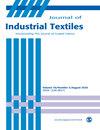Optimization of tire-ground performance through meshed belt layer structure
IF 2
4区 工程技术
Q1 MATERIALS SCIENCE, TEXTILES
引用次数: 0
Abstract
Using Abaqus finite element software, this study investigates the impact of different carcass belt layer structures on the grounding characteristics of tires. Focusing on the 215/55R17 radial tire, the research proposes a structural optimization scheme and establish a finite element model. The standard tire belt layer structure is replaced with a mesh belt layer structure to achieve optimized performance. Through static loading tests on the tire, the accuracy of the finite element model was validated. By altering the density, number of layers of the mesh belt structure, and radial load of the tire, a simulation analysis is conducted to study the impact on tire deformation and stress on the carcass material. The optimized tire features increased radial stiffness and reduced tread wear. The density of the mesh belt layer in the contact area affects tire deformation as well as the stress on the belt layer and ply layer. The results indicate that the mesh belt layer can effectively absorb the radial load of the tire, optimizing tire deformation by 20% to 30%. Under different loads, the tire with a 70-density mesh belt layer can reduce surface stress by approximately 40%, or around 230J. The mesh belt layer tire can reduce the sensitivity of the tire center to high load stresses, optimizing 25% of the concentrated stress at the shoulder position of the ply layer. When a double-layer belt is used, the strength at the shoulder increases with the number of belt layers, reducing stress by approximately 2-4N. The structural form of the belt layer has little impact on the trend of stored strain energy changes, but the number of belt layers significantly affects the amount of change in the tire’s strain energy. On average, about 10% of the stored strain energy is reduced due to changes in the belt layer structure.通过网格带层结构优化轮胎-地面性能
本研究使用 Abaqus 有限元软件研究了不同胎体带束层结构对轮胎接地特性的影响。研究以 215/55R17 子午线轮胎为重点,提出了结构优化方案并建立了有限元模型。用网状带层结构取代标准轮胎带层结构,实现性能优化。通过对轮胎进行静态加载试验,验证了有限元模型的准确性。通过改变网格带结构的密度、层数和轮胎的径向载荷,进行了模拟分析,以研究轮胎变形和胎体材料应力的影响。优化后的轮胎增加了径向刚度,减少了胎面磨损。接触区网状带束层的密度会影响轮胎变形以及带束层和帘布层的应力。结果表明,网状带束层可以有效吸收轮胎的径向载荷,使轮胎变形优化 20% 至 30%。在不同载荷下,采用 70 密度网状带束层的轮胎可减少约 40% 的表面应力,约为 230J。网状带束层轮胎可降低轮胎中心对高负荷应力的敏感性,优化帘布层肩部位置 25% 的集中应力。当使用双层带束层时,肩部的强度会随着带束层数的增加而增加,可减少约 2-4N 的应力。带束层的结构形式对储存应变能的变化趋势影响不大,但带束层的数量对轮胎应变能的变化量影响很大。由于带束层结构的变化,平均约有 10% 的存储应变能被降低。
本文章由计算机程序翻译,如有差异,请以英文原文为准。
求助全文
约1分钟内获得全文
求助全文
来源期刊

Journal of Industrial Textiles
MATERIALS SCIENCE, TEXTILES-
CiteScore
5.30
自引率
18.80%
发文量
165
审稿时长
2.3 months
期刊介绍:
The Journal of Industrial Textiles is the only peer reviewed journal devoted exclusively to technology, processing, methodology, modelling and applications in technical textiles, nonwovens, coated and laminated fabrics, textile composites and nanofibers.
 求助内容:
求助内容: 应助结果提醒方式:
应助结果提醒方式:


